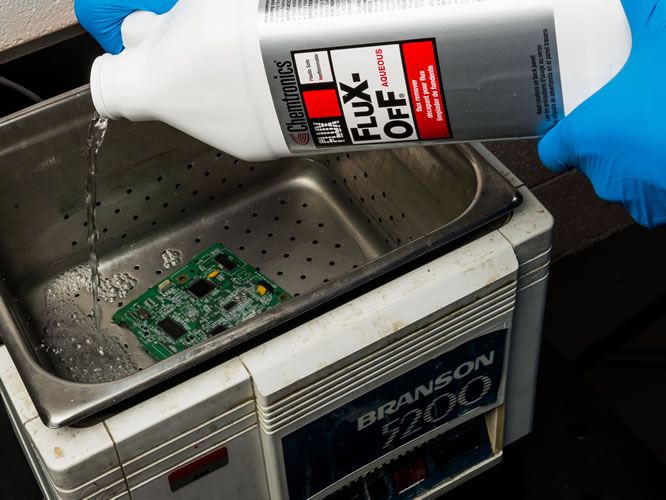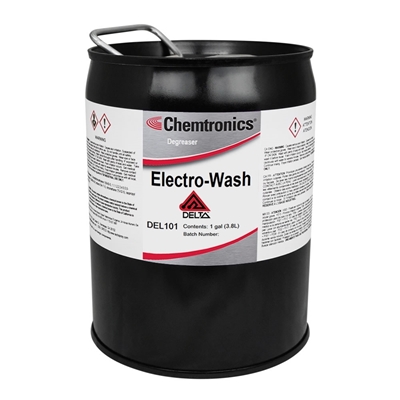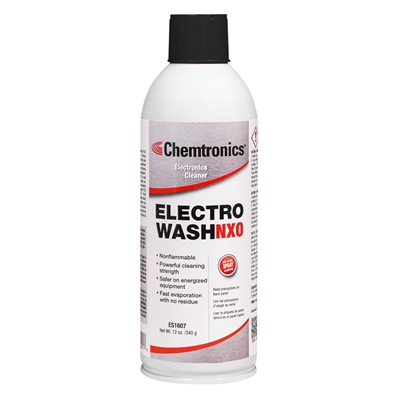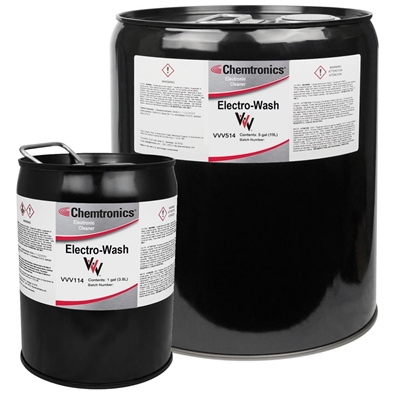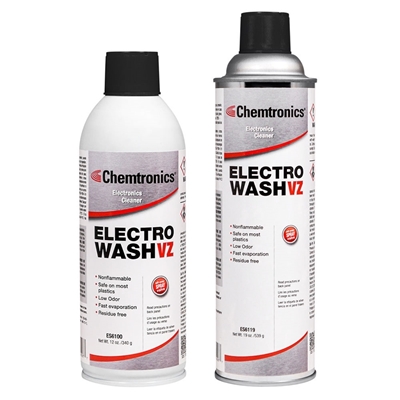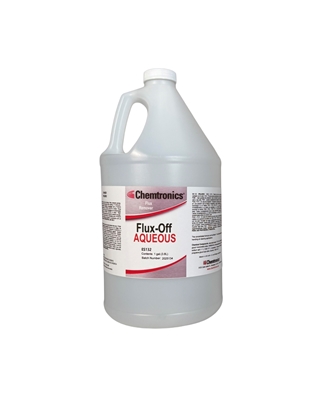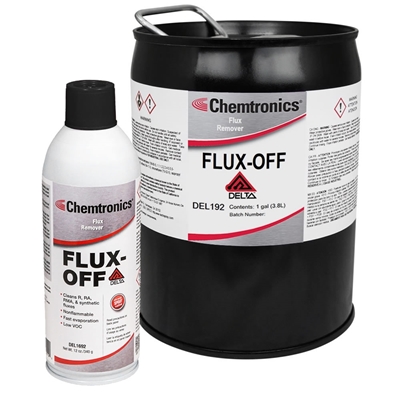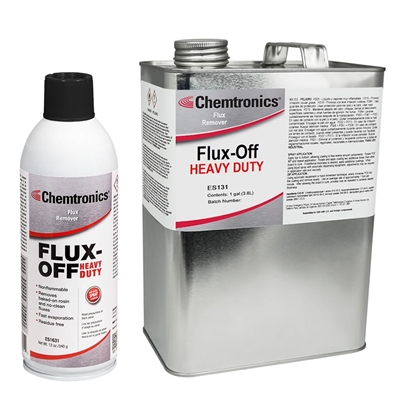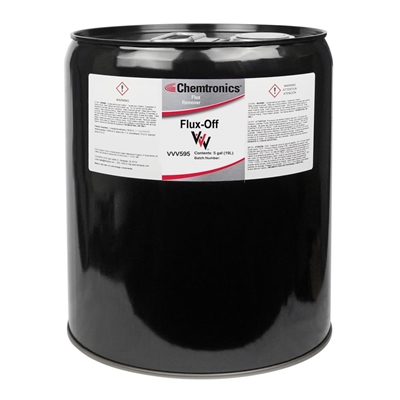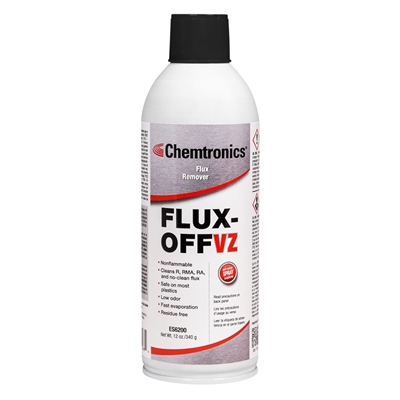Cleaning with a combination of a solvent and ultrasonic cleaning equipment is a popular choice when companies in heavy industry, electronics, medical electronics and aerospace industries need to aggressively remove stubborn soils.
An ultrasonic cleaning process utilizes equipment to transmit ultrasound waves to break apart fluxes, heavy greases, waxy corrosion inhibitors, and other challenging contamination. Those soils will then flow off the parts and into the cleaning solution.
Ultrasonic equipment varies widely in power and size from small benchtop units, like you find in jewelry stores, to large industrial model, with brands like Crest Ultrasonics and Branson Ultrasonics.
Ultrasonic cleaning units have a tank or chamber that holds the liquid cleaner and transducers that transmit sound waves into the chamber. Parts can be placed directly into the chamber, or contained in a basket to make it easier to submerge and remove smaller components. Some equipment have heating elements for improved cleaning performance. Controls are often available to change the strength (amplitude) of the sonics, temperature of the solvent, or to set a shut-off timer.
How Does Ultrasonic Equipment Work?
An ultrasonic cleaning process utilizes equipment to transmit ultrasound waves, generally between 20-40 kHZ. The transducers send sound waves through the liquid cleaner, which acts as a transfer medium from the transducers to the parts.
At very high frequency, the waves pass over the surface of the parts creating agitation through a process called acoustic streaming. Lower frequencies create cavitation within the liquid. These voids quickly collapse, generating heat and shock waves, which creates agitation in the cleaning process.
Are There Disadvantages to Ultrasonic Cleaning?
Ultrasonic cleaning has the potential to cause damage to delicate parts and surfaces. For electronics, these would be ceramic-based components while for micro-electromechanical systems (MEMS) it is gyroscopes, accelerometers or microphones that are of particular concern.
At the lower end of the frequency range, the cavitation bubbles are larger and transfer more energy to the soil. While that can lead to more aggressive cleaning, it can also damage sensitive parts and surfaces. In contrast, the smaller cavitation bubbles at higher frequencies can penetrate into tighter surface areas and are less likely to cause damage to the parts. The cleaning action may not be as aggressive, so higher temperatures or more time may be needed for adequate cleaning.
It is helpful to think of it like coarse-grade sandpaper (low frequency) versus fine sandpaper (high frequency). Coarse sandpaper will make faster work of removing material, but is more likely to damage what’s underneath.
Another potential problem with ultrasonic cleaning is cross-contamination. When the soil breaks down and flows off the part, it contaminates the solvent. This creates the possibility that the dissolved soil will redeposit onto the next part(s) to be cleaned. Cross-contamination can be reduced with a final rinse in virgin solvent or a pass through the vapor zone of a vapor degreaser.
How Do You Maximize Cleaning Performance with Ultrasonic Equipment?
Several adjustments can be made to increase the cleaning performance of your ultrasonic process:
- Frequency – This is the number of waves in a second, so how “tight” the wave form is. Lower frequencies provide more aggressive cleaning, but increased potential to damage sensitive surfaces and components. High frequency sonic waves can penetrate into tighter areas. As you get over 400 kHz, in the mega-sonic range, the bubble collapse is not as violent due to smaller spacing, so cleaning is often less effective in tight areas.
- Amplitude – This is the height of the wave, or the loudness. Greater amplitude will generally increase cleaning effectiveness, but also the potential for damage to delicate surfaces or components.
- Temperature – Increased temperature generally improves the cleaning performance of a solvent. Higher temperatures can also reduce the viscosity of the cleaner and increase the surface tension, allowing the solvent to enter tighter areas. Cleaning performance increases significantly if the temperature of the solvent is above the melting point of the soil.
- Time – Increase the time of the cleaning cycle to compensate for lower than optimal solvency.
- Chemistry – If the chemistry has a good solvency match to the soil, less sonic agitation will be needed. This allows you to run your cleaning process more quickly, at lower temperatures and lower amplitudes, decreasing the likelihood of damaging sensitive components.
What Is the Best Cleaning Solvent for an Ultrasonic Process?
If the chemistry is a good solvency match to the soil, less sonic agitation will be needed. This allows you to run your cleaning process more quickly, at lower temperatures and amplitude, decreasing the likelihood of damaging sensitive components. The following are characteristics to look for when reviewing options:
- Solvency – Ability of the cleaner to breakdown and dissolve the soil. For a quick evaluation of solvency, place a drop of cleaner directly on the soiled part, let it sit for a few minutes, and then blot it dry. From this simple test, you can generally tell if the chemistry is a good match to the soil. If the cleaner just sits on the surface of the soil, and doesn’t wet and start to break down the soil, move on to the next cleaner.
- Surface tension – This impacts how well a solvent can get into tight crevices, like under low stand-off components.
- Density – Density can have a minor impact on how quickly the sonic waves travel through the liquid, and the amount of cavitation. A higher density material requires more energy to move, so could deplete the energy, thus the cleaning power, by the time it reaches the part.
Other characteristics can also play a part in the safety and regulatory compliance of a solvent:
- Flammability – Narrow your selection down to a nonflammable cleaner to prevent flammable vapors from accumulating or propagating.
- Toxicity - Chemtronics offers innovative solvents that are much safer than the four most common industrial solvents: trichloroethylene (TCE), n-propyle bromide (nPB), perchloroethylene (perc) and Methylene Chloride. No Chemtronics ultrasonic cleaners contain these highly toxic solvents, and Flux-Off Tri-V and Electro-Wash Tri-V are products specifically engineered to act as replacements.
- Environmental issues - Some state (e.g., CARB, the California Air Review Board), municipal, and even industry-specific regulations restrict the use of high VOC or high GWP materials. Volatile organic compounds (VOCs) are materials that add to smog. Global warming potential (GWP) for solvents is specified in relation to CO2. CO2 is designated 1, so as an example, a solvent with GWP of 500 would have 500 times the global warming impact of CO2.
Chemtronics Ultrasonic Cleaners
Chemtronics offers a variety of ultrasonic cleaners:
- Electro-Wash Tri-V and Flux-Off Tri-V High Performance Cleaners - nonflammable solvents that quickly remove flux, grease, oils, dirt, dust, and other contaminants from metal parts and electronic components and assemblies. Tri-V cleaners are engineered to replace toxic solvents like nPB and TCE.
- Electro-Wash Delta and Flux-Off Delta Precision Cleaners - Extra strength, nonflammable solvents that quickly remove all contaminants and evaporate quickly without leaving residue. Delta cleaners are low VOC and GWP for regulatory compliance.
- Flux-Off Aqueous - Extra-strength water-based cleaner for all rosin and no-clean flux types from electronic sub-assemblies, printed circuit boards and all other electronic components. It can be diluted 1:10 with deionized water to reduce cost and environmental impact.
Chemtronics’s lab is available to help you qualify products, establish cleaning procedures, or diagnosing cleaning issues. For more information, go to write to [email protected] or call 770-424-4888.

